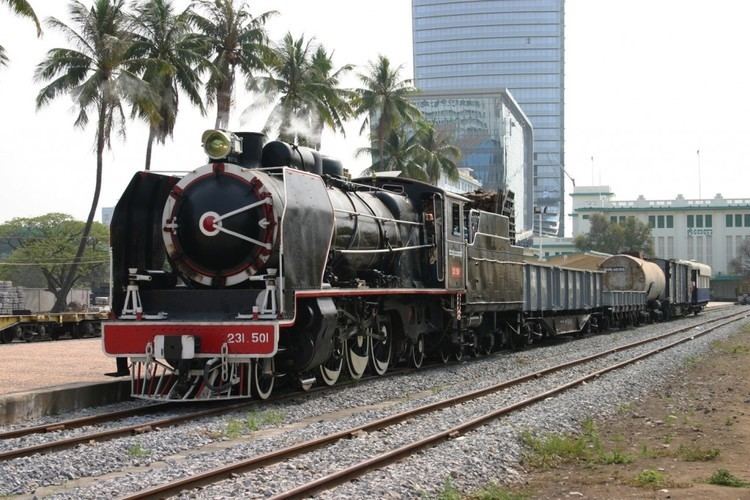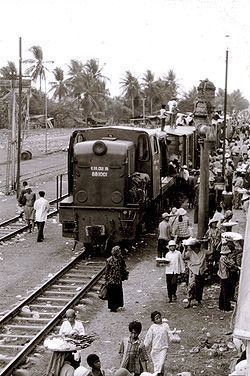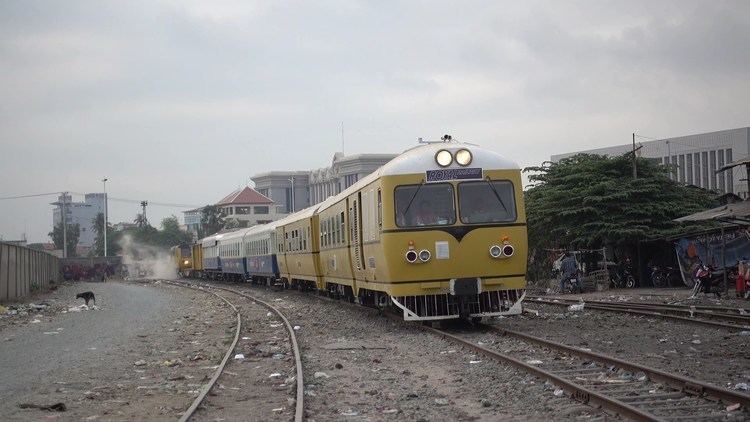National railway Toll Royal Railways Electrified 0 km (0 mi) | Ridership ? High-speed 0 km (0 mi) | |
 | ||
Total 612 kilometres (380 mi) Main 1,000 mm (3 ft 3 ⁄8 in) | ||
Cambodia has 612 km (380 mi) of 1,000 mm (3 ft 3 3⁄8 in) metre gauge rail network, consisting of two lines originally constructed during the time when the country was part of French Indochina. Due to neglect and damage from civil war during the latter half of the 20th century, the railways were in a dilapidated state and all services had been suspended by 2009. As of 2016 freight and limited passenger service are available between Phnom Penh and Sihanoukville. Proposals to repair or replace the line from Phnom Penh to Battambang and the Thailand border are being discussed.
Contents
- Recent developments
- French colonial era
- Late 20th century
- 21st century
- Historical
- Locomotives
- Railway links with adjacent countries
- 2006
- 2007
- 2008
- 2009
- 2010
- 2012
- 2014
- 2015
- 2016
- Bamboo Railway
- References

Recent developments

The railways are currently being rehabilitated by the Government of Cambodia, with funding from the Asian Development Bank, Australian Agency for International Development (AusAID) and Australian company Toll Holdings, to be operated under the name Toll Royal Railways and to complete a missing link in the Trans-Asian Railway. The first line to be reopened as part of this project was the 117 km (73 mi) section between Phnom Penh and Touk Meas in October 2010. The complete Southern line to Sihanoukville Port actually opened, for freight traffic, in January 2013, some 18 months behind schedule.

The Western line connecting to the Thai rail network at Poipet is currently being reconstructed, scheduled to open in phases during 2014 and 2015, and a new railway connecting Phnom Penh to Ho Chi Minh City is in planning, which would complete the rail link from Singapore to Kunming.
China Railway Group is planning to build a 405 km north-south railway across Cambodia, which would support planned expansion of the steel industry in Cambodia.
Scheduled passenger train services between Phnom Penh and Sihanoukville will resume on April 9, 2016 after having been suspended for 14 years, according to a statement issued by Cambodian company Royal Railway on March 28.
French colonial era
The French colonial government built the first line, which runs from Phnom Penh to Poipet on the Thai border, between 1930 and 1940, with Phnom Penh Railway Station opening in 1932. The final connection with Thailand was completed by the Royal State Railways in 1942. However, the service from Bangkok to Battambang was suspended when the French Indochinese Government resumed sovereignty over Battambang and the Sisophon area from Thailand on December 17, 1946, as Thailand was seen as a supporter of Khmer Issarak, the anti-French, Khmer nationalist political movement.
Phnom Penh - Pursat - Moung Ruessei - Battambang - Sisophon - Poipet
Late 20th century
In 1955 Australia donated rolling stock, described as "railway wagons of various types", worth at the time ₤A441,000, and "needed for new rail links." Assistance from France, West Germany, and the People's Republic of China between 1960 and 1969 supported the construction of the second line, which runs from Phnom Penh to Sihanoukville on the southern coast to cut down the reliance on Saigon Port of Vietnam and Khlong Toei Port of Thailand. In 1960, Australia provided four third-class passenger carriages under the Colombo Plan. Rail service ceased during the war but resumed in the early 1980s. Guerrilla activities, however, continued to disrupt service.
21st century
However, by 2008 the service between Phnom Penh and Battambang had been reduced from daily to weekly service due to the lack of funds to maintain the tracks and rolling stock. Even the new diesel-electric locomotives from China could not run on the tracks due to the dilapidated condition. Derailing of trains in operation was not infrequent. As reported by the Phnom Penh Post in October 2008, the national railway earned merely $2 million per year; the annual freight amount stood at 350,000, and the passenger count at 500,000.
The last regular rail service in Cambodia between Phnom Penh and Battambang was suspended entirely in early 2009, however in June of that year Australian business Toll Holdings was awarded the contract to begin reconstruction of Cambodia's rail network and to operate it once complete. It is envisioned that this line would reopen by mid-2013, together with the track further west to the Thai border, allowing for direct rail services into Cambodia from Bangkok for the first time in over 60 years.
In March 2012, Toll said that it would suspend its involvement in the railway project due to delays, caused by lack of equipment, 2011's flood rains, and the resettlement of thousands of Cambodians. The line from Phnom Penh to the deep water port at Sihanoukville was also scheduled to be reopened in 2011. However, the company came back in late July and said it will start transporting construction materials needed to build the southern line from 1 August.
The Australian government and the Asian Development Bank was said to spend $26 million to help rebuild Cambodia's rail system, the majority of the Northern and Southern lines in Cambodia. The project, if all up, would cost $143 million, with the disruption exposed in a report by the international consortium funding the $143 million project - Australia's international aid agency AusAID and the Asian Development Bank. 641 kilometers of track will be rehabilitated with the aim of integrating Cambodia with the regional network such as Vietnam and Thailand; however,about 1,400 families who are living in shanty towns, have been affected and 1050 families have had to move. The report which was prepared by AusAID and Asian Development Bank experts in April 2012 pointed out poor construction and botched surveys leading to evictions of families, infighting between contractors, delays and cost overruns.
In June 2012, Cambodia was discussing with the Chinese government on funding for a 250-kilometre stretch of rail line between Cambodia and Vietnam. Var Sim Sorya, director general of Ministry of Public Works and Transportation said: "China doesn’t have so many conditions, but Chinese technicians are still well-studied," he said yesterday at a workshop on infrastructure, although he did not specify which conditions were undesirable.
The line between Phnom Penh and the South opened to travellers in April 9, 2016.
Historical
Locomotives
CSR Qishuyan Locomotive Company of China has supplied diesel-electric locomotives of type CKD6D to Cambodia Royal Railway. These are 880 kW Bo-Bo locomotives with Caterpillar CAT3508B diesel engines.
Railway links with adjacent countries
2006
2007
2008
2009
2010
2012
2014
2015
2016
Bamboo Railway
The Bamboo railway as it is known to overseas visitors, "norry" or "lorries" as it is known to locals is a popular form of transport in the Northwestern area of the country near Battambang. The trains consist of a bamboo-covered platform and two detached axles with wheels. They run on regular tracks and are powered with scavenged engines, such as Briggs & Stratton type air-cooled gasoline engines adapted from portable electricity generators, or from water pumps Power is transmitted by belt and pulley. Trains can reach up to 40 km/h. When meeting traffic in the opposite direction, passengers of the cart with fewer passengers are expected to lift the platform, engine, and axles of their cart off the tracks to let the other cart pass.
